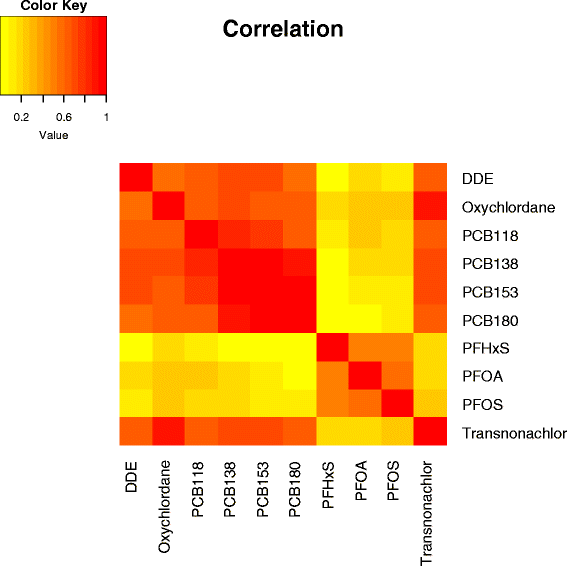Concentrations of persistent organic pollutants in maternal and cord blood from the maternal-infant research on environmental chemicals (MIREC) cohort study
- PMID: 27142700
- PMCID: PMC4855498
- DOI: 10.1186/s12940-016-0143-y
Concentrations of persistent organic pollutants in maternal and cord blood from the maternal-infant research on environmental chemicals (MIREC) cohort study
Abstract
Background: Pregnant women are an especially important population to monitor for environmental exposures given the vulnerability of the developing fetus. During pregnancy and lactation chemical body burdens may change due to the significant physiological changes that occur. Developmental exposures to some persistent organic pollutants (POPs) have been linked with adverse health outcomes.
Methods: First trimester maternal and cord blood plasma concentrations of several POPs including polychlorinated biphenyls (PCBs), organochlorine pesticides (OCs), polybrominated diphenyl ethers (PBDE)s and perfluoroalkyl substances (PFASs) were measured in samples from 1983 pregnant women enrolled in the Maternal-Infant Research on Environmental Chemicals (MIREC) cohort. Predictors of exposure were also identified.
Results: In maternal plasma, there was >90 % detection for the perfluoroalkyl substances (PFASs) perfluorooctanoic acid (PFOA), perfluoroctane sulfonate (PFOS), perfluorohexane sulfonate (PFHxS), and dichlorodiphenyldichloroethylene (DDE), oxychlordane and PCB 138 and 153. Cord blood plasma had much lower detection rates with low or very limited detection for most PCBs and PBDEs. The PFASs were the most frequently detected (23-64 %) chemical class in cord plasma. In a subset of 1st and 3rd trimester paired samples, PFAS concentrations were found to be strongly correlated and had ICCs ranging from 0.64 (PFOA) to 0.83 (PFHxS). The cord:maternal plasma concentration ratios ranged from 0.14 (PFOS) to 0.87 (oxychlordane, lipid adjusted). Similar to other studies, we found parity, maternal age, income, education, smoking status, pre-pregnancy BMI and fish consumption to be significant predictors for most chemicals. Those participants who were foreign-born had significantly higher concentrations of organochlorinated pesticides and PCBs.
Conclusions: In the MIREC study, multiple chemical contaminants were quantified in the plasma of pregnant women. In cord plasma PFOA had the highest detection rate. However, compared to other Canadian and international population studies, the MIREC participants had lower contaminant concentrations of these substances.
Keywords: Cord plasma; DDT; Maternal plasma; PBDEs; PCBs; PFASs; POPs; Pregnant.
Figures
Similar articles
-
Food intake and serum persistent organic pollutants in the Greenlandic pregnant women: The ACCEPT sub-study.Sci Total Environ. 2015 Oct 1;529:198-212. doi: 10.1016/j.scitotenv.2015.05.022. Epub 2015 May 23. Sci Total Environ. 2015. PMID: 26011616
-
Persistent organic pollutants and mortality in the United States, NHANES 1999-2011.Environ Health. 2017 Oct 10;16(1):105. doi: 10.1186/s12940-017-0313-6. Environ Health. 2017. PMID: 29017533 Free PMC article.
-
Univariate predictors of maternal concentrations of environmental chemicals: The MIREC study.Int J Hyg Environ Health. 2017 Mar;220(2 Pt A):77-85. doi: 10.1016/j.ijheh.2017.01.001. Epub 2017 Jan 16. Int J Hyg Environ Health. 2017. PMID: 28109710
-
Perfluoroalkyl chemicals and human fetal development: an epidemiologic review with clinical and toxicological perspectives.Reprod Toxicol. 2009 Jun;27(3-4):212-230. doi: 10.1016/j.reprotox.2009.02.001. Epub 2009 Feb 20. Reprod Toxicol. 2009. PMID: 19429401 Review.
-
Persistent organic pollutants and couple fecundability: a systematic review.Hum Reprod Update. 2021 Feb 19;27(2):339-366. doi: 10.1093/humupd/dmaa037. Hum Reprod Update. 2021. PMID: 33147335 Free PMC article.
Cited by
-
Implementation of human biomonitoring in the Dehcho region of the Northwest Territories, Canada (2016-2017).Arch Public Health. 2018 Dec 3;76:73. doi: 10.1186/s13690-018-0318-9. eCollection 2018. Arch Public Health. 2018. PMID: 30524727 Free PMC article.
-
Assessment of neurotransmitter release in human iPSC-derived neuronal/glial cells: a missing in vitro assay for regulatory developmental neurotoxicity testing.Reprod Toxicol. 2023 Apr;117:108358. doi: 10.1016/j.reprotox.2023.108358. Epub 2023 Mar 1. Reprod Toxicol. 2023. PMID: 36863571 Free PMC article.
-
Evaluating maternal exposure to an environmental per and polyfluoroalkyl substances (PFAS) mixture during pregnancy: Adverse maternal and fetoplacental effects in a New Zealand White (NZW) rabbit model.Sci Total Environ. 2022 Sep 10;838(Pt 4):156499. doi: 10.1016/j.scitotenv.2022.156499. Epub 2022 Jun 6. Sci Total Environ. 2022. PMID: 35679923 Free PMC article.
-
Characterization of per- and polyfluoroalkyl substances (PFAS) concentrations in a community-based sample of infants from Samoa.Chemosphere. 2024 Apr;353:141527. doi: 10.1016/j.chemosphere.2024.141527. Epub 2024 Feb 22. Chemosphere. 2024. PMID: 38401869 Free PMC article.
-
Exposure to Persistent Organic Pollutants and Birth Characteristics: The Upstate KIDS Study.Epidemiology. 2019 Nov;30 Suppl 2(Suppl 2):S94-S100. doi: 10.1097/EDE.0000000000001095. Epidemiology. 2019. PMID: 31569158 Free PMC article.
References
-
- The Secretariat of the Stockholm Convention. Stockholm Convention on Persistent Organic Pollutants (POPs) as amended in 2009. http://chm.pops.int/Convention/ThePOPs/ListingofPOPs/tabid/2509/Default.... Accessed 21 Feb 2016.
-
- Health Canada . Report on Human Biomonitoring of Environmental Chemicals in Canada: Results of the Canadian Health Measures Survey Cycle 1 (2007-2009) Ottawa: Health Canada; 2010.
-
- CDC. Fourth National Report on Human Exposure to Environmental Chemicals. Atlanta, GA: Department of Health, Centers for Disease Control and Prevention, 2009. http://www.cdc.gov/exposurereport/. Accessed 12 Apr 2016.
-
- CDC . Fourth National Report on Human Exposure to Environmental Chemicals: Updated Tables, August 2014. Atlanta: U.S. Department of Health and Human Services; 2014.
MeSH terms
Substances
LinkOut - more resources
Full Text Sources
Other Literature Sources
Miscellaneous


